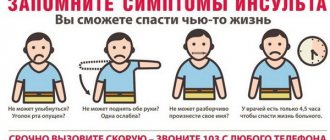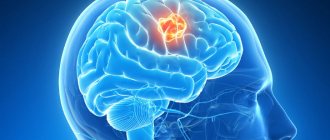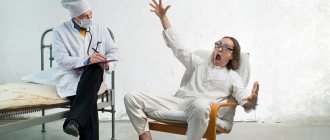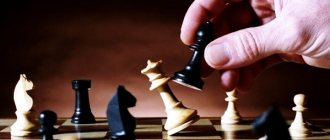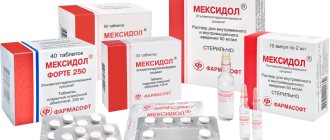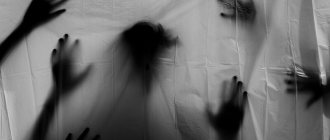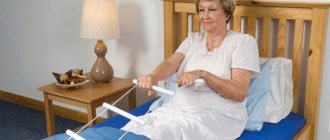Stroke (acute vascular accident) is an acute disorder of cerebral circulation leading to focal damage to the brain.
There are two types of stroke.
- Ischemic stroke (cerebral infarction) occurs when the patency of the cerebral arteries is impaired, which leads to prolonged ischemia and irreversible changes in brain tissue in the area of the blood supply to the affected artery.
- Hemorrhagic stroke is caused by a pathological rupture of a cerebral vessel with hemorrhage into the cerebral tissue.
It is noted that the first type of stroke is typical for people aged 55-60 years, and the second - for younger people (45-55 years).
Symptoms of a stroke:
- general cerebral symptoms (headache, vomiting, nausea, confusion),
- sudden weakness in the limbs,
- facial asymmetry due to spasms of the facial muscles,
- speech and vision impairment,
- swallowing dysfunction,
- dizziness,
- vomit,
- ataxia (loss of coordination),
- cramps on one side of the body,
- skin redness,
- fainting, etc.
The causes of stroke are: circulatory disorders, coronary heart disease, myocardial infarction, vascular diseases, changes in brain activity, abnormalities of cerebral vessels, thromboembolism, hypertension, atherosclerosis, dyslipidemia, cerebral artery aneurysm, unhealthy diet (obesity in women), smoking, alcoholism (in men), sedentary lifestyle, stress, etc.
Briefly about the important, or get acquainted - stroke
During a stroke, the blood supply to an area of the brain is disrupted.
As a result, the blood vessels are affected, and the brain does not receive the necessary oxygen supply, and the nerve cells gradually die. Associated symptoms are:
- disorders of the motor system on one side;
- sensory disorders;
- lesions of central motor neurons;
- loss of consciousness;
- coma.
People of all ages are susceptible to stroke, especially those who suffer from heart disease and high blood pressure. The risk group includes patients with obesity, diabetes mellitus and those who abuse bad habits.
Micro-strokes foreshadow an upcoming brain catastrophe. You should pay close attention to the first symptoms, since even short-term vascular disorders lead to pathological changes in the brain substance.
Doctors can handle stroke treatment. Certain drugs restore damaged areas of nervous tissue and protect nerve cells from destruction.
However, complete recovery depends on the patient himself. Impaired brain circulation signals that you need to change your life, and not feel sorry for yourself.
Space for healing life. Personal website of Elena Barymova
The Second Biological Law
speaks of the two-phase nature of all significant Special Biological Programs (provided that the initial conflict is resolved by the individual). .
.
Third Biological Law
talks about exactly how certain tissues/organs/systems of our body react in each phase of SBP. It is the view of the organic and functional behavior of tissues and organs that is the basis of this Law. And this behavior can be completely opposite: cells (function) of tissues controlled from the ancient brain (stem and cerebellum), in the SA phase (the first phase of SBP - the phase of conflict activity) increase their number (cell proliferation) and, accordingly, have an increase functions, and after the conflict is resolved in the PCL phase, they degrade and the function is restored to normal values; cells (functions) of tissues controlled from the new brain (cerebral hemispheres) first reduce their number (tissue degradation - ulceration, necrosis) in the SA phase with a corresponding decrease in function, and then are restored (cell proliferation) in the PCL phase with a corresponding restoration of function . .
.
If you look at the above graph of the course of any SBP, you can see that the “large” recovery phase (PCL phase) has three sections - PCL-A, epicrisis and PCL-B. The PCL-A phase is called the “edema phase” because It is during this period of time that restorative edema
both in the organ (tissue) that was hit by the conflict, and in the corresponding brain relay from where this organ (tissue) is controlled.
This swelling has a restorative function, because... the cells of our body in an aquatic environment are restored faster and more correctly (the body itself, on command from the brain, “pumps” water to the place that is being “repaired” - for faster and better recovery). . But it is not only in the tissue that edema occurs, exactly the same process occurs in the brain
- so that the corresponding relay is also restored from the impact of the conflict.
. The cerebral cortex (gray matter), relative to the overall size of the brain, has a small thickness - in different parts of the cerebral hemispheres it ranges from only 1.3 to 4.5 mm. The structure that it covers (parenchyma of the cerebral hemispheres or white matter) is much more “massive”. The figure below, although not to scale, gives an idea of the size relationship: . . For example, if a person experiences a conflict of self-depreciation
of relatively small strength, then after it is resolved, he will develop swelling in the “big brain” (swelling A in the next figure), which he will not really even feel.
A social conflict
of the same strength with the occurrence of restorative edema in the cerebral cortex will give already noticeable manifestations - a temporary “loss” of function (edema B). But as for pain, swelling of this size will not cause (except for functional impairment) any pain, because the brain itself has no sensitivity. .
. The next option is that a person experiences the same conflicts (two different conflicts - for the parenchyma and the cerebral cortex), but with greater force, or remains in them longer than in the first case (i.e., in the active phase of the SBP, a large accumulation occurs masses of conflict). Accordingly, the recovery edema will be larger in size: .
.
But if for the parenchyma of the cerebral hemispheres this case also does not give any visible changes in behavior or pain, then for the thin cortex, edema of this size will be very “serious” - loss of function can be very strong and very long-lasting - that same stroke ( if the motor cortex is affected). . This option is also possible: a person experiences only one type of conflict, which seems to be not directly related to society and the movement - a conflict of self-depreciation
.
But it remains in it for quite a long time, with the accumulation of a large mass of conflict.
For example, a teenager has been hearing the words of a teacher for a whole year: “You’re a moron, you’ll get a two for the Unified State Examination and you’ll work as a janitor all your life.” After the conflict is resolved (the child did pass the exams normally and entered college), the body is restored with the formation of edema in the corresponding brain relay. .
.
But, since this swelling is so large that it “affects” the cortex (in the motor zone), this swelling also causes loss of motor function - all the signs of a stroke are evident. If the sensory cortex is affected (even without a corresponding sensory conflict
), there will be a loss of sensory function.
If the part of the cortex responsible for the functioning of the inner ear is affected (even without a corresponding “fall conflict” or auditory conflict
), there will be dizziness (temporary loss of the “stabilization” function) or hearing impairment.
If the part of the cortex responsible for vision is affected (even without a corresponding visual conflict
), there will be a loss of visual function.
And so on. As soon as the swelling subsides, the function will be restored. . Large swelling can occur in two cases. The first has already been described above - this is a long “sticking” in a conflict with the accumulation of a large mass of the conflict and a corresponding long-term recovery edema. The second possibility is the so-called “Syndrome”
- the simultaneous presence of excess water in the body due to an active conflict for the collecting ducts of the kidneys.
. The launch of the Special Biological Program for the collecting ducts of the kidneys is caused by a conflict of existence (existential conflict), a refugee conflict
, "losing everything" or a feeling as if "everything has been bombed" or "I am like a fish thrown onto the shore."
. For example, this could be a fear of rough hospital procedures (“hospital conflict”), a conflict of abandonment, loneliness, a conflict of feelings of lack of care or poor care, a conflict of feeling “like in the desert” (literally “without water”). The biological rationale for SBP for these conflicts is to conserve water to extend survival time because you are disoriented and in a hostile environment (like a fish out of water or a desert with no water) - an archaic but extremely important biological rationale. . For an animal in the wild, this situation is likely to persist for several days, otherwise it faces death from dehydration. In humans, this program is often activated
due to loneliness or despair, rather than due to an actual lack of water.
. Many exacerbations
of various diseases that are considered pathological occur because the patient feels “stranded on the shore of life,” partly due to the disease, and the meaning of his existence disappears.
Thus, renal collecting duct SBP is also often referred to as a “hospital conflict” program. For this reason, symptoms in the hospital, especially in the intensive care unit, always worsen significantly. The person is lonely and abandoned in an emotionally cold “climate”. Therefore, to reduce exacerbations, warm care for the patient is necessary so that he does not feel “on the sidelines of life.” . The “loss” of the function has been sorted out. Now about the pain
.
As has already been said, the brain itself does not have sensory sensitivity (Hannibal Lecter, I remember, ate the brain of a living person with a spoon, and he didn’t care, even in a film - it is unlikely that the creators of this “masterpiece” greatly sinned against the truth) . But the brain is covered with a membrane - and it already has sensory sensitivity. The periosteum of the inner surface of the skull is also sensitive. If the swelling is large and “bursts the head from the inside,” then it is these tissues (membranes) that will cause very severe pain for the duration of the swelling. . The main signs of a stroke are very well illustrated by everything that is written above (on request “stroke symptoms” the Internet shows something like this list, in green
):
— the symptoms of a stroke depend on which part of the brain is damaged and in which hemisphere the stroke occurred. In some rare cases, a person may not know that they have had a stroke (when the stroke is asymptomatic - i.e. when the swelling is small
).
Symptoms usually develop suddenly, or may come and go within a day or two ( swelling in the cerebral cortex and related tissues and organs controlled from the cortex can occur within minutes - i.e. very quickly, as e.g. , Quincke's edema
). Symptoms usually become more severe early in the course of a stroke, but they can gradually worsen if treatment is not started promptly.
The main symptom is a very severe headache
, which appears suddenly without any reason:
- appears suddenly ( swelling in the cortex occurs quickly, sometimes in a matter of minutes
);
- very severe pain ( a sign of large edema and strong intracranial pressure
);
- appears when a person is lying down ( in a vertical position, due to the action of gravity, the pressure on the meninges can decrease, and in a lying position, on the contrary, it can increase
);
- intensifies when a person changes position, bends over, coughs or strains ( the same thing, see the previous paragraph
).
Other symptoms depend on the severity of the stroke and its location:
- drowsiness, loss of consciousness, coma - may occur, but not always (“loss” or decrease in relevant brain functions
);
- hearing impairment - decreased hearing sensitivity or complete absence on one or both sides ( if the part of the cortex responsible for hearing is involved
);
- taste disturbance - decreased sensitivity of taste, or absence of taste, or incorrect perception of taste, on the entire surface of the tongue or part of it ( if the part of the cortex responsible for the perception of taste is involved
);
- impaired tactile sensitivity and feelings of pain - usually a decrease in the feeling of pressure, pain, temperature, touch, in any part of the body ( if the sensory cortex of the brain is involved
);
- confusion in thoughts, memory loss ( separation conflicts acting on the sensory cortex of the brain, with great strength or duration (relapses) - Alzheimer's disease
);
- difficulty swallowing ( decreased innervation of the swallowing muscles
);
- impaired ability to write or read - a person cannot write simple words and sentences; a person cannot read a word or sentence, does not recognize letters; - dizziness or a feeling of rotation, imbalance, loss of coordination and orientation in space ( part of the cortex responsible for the inner ear
);
- impaired control of urination and defecation ( decreased innervation of the corresponding muscles)
;
- severe muscle weakness in the arm, leg or face - most often only on one half of the body ( decreased innervation of the corresponding muscles)
;
- movement disorder - a person cannot move an arm or leg on one side of the body or on both sides ( decreased innervation of the corresponding muscles)
;
- numbness or tingling in an arm or leg - often only on one half of the body ( separation conflicts affecting the sensory cortex of the brain
);
- visual impairment - decreased visual acuity, double vision, loss of vision, may affect one or both eyes ( if the part of the cortex responsible for vision is involved
);
- impaired speech or speech understanding - a person cannot pronounce words correctly or cannot speak at all; the person does not understand what is being said to him or what is being discussed ( parts of the cortex responsible for muscle movement, or the frontal lobes for awareness of information are involved
);
. Information on how and what first aid to provide if a person next to you shows signs of a stroke is very useful for any person. Correct application of these rules can help a person, in principle, stay alive during an acute attack. In any case, the first thing you need to do is call an ambulance, since a stroke is an emergency and requires immediate qualified medical care. While waiting for the ambulance, you should do the following (comments marked
in green are mine)
:
- if the person is conscious, position him so that his shoulders and head are slightly higher than his body, this will reduce blood pressure (in most cases - edema)
on the brain.
Try to avoid moving or shifting, as this may aggravate the condition; - under no circumstances give him anything to eat or drink. A person may have impaired swallowing function and food or liquid may enter the respiratory tract (very useful advice and also absolutely correct from the point of view of the Biological Laws and principles of the course of SBP: in addition to a possible decrease in swallowing function, additional water in the body is certainly not needed at the moment )
;
- under no circumstances give any medications before the ambulance arrives, you can do more harm than help; - remove any secretions and objects from the oral cavity (saliva, blood, mucus, food); - provide access to fresh air, and also remove clothing that interferes with free breathing; - if a person is unconscious but breathing, he must be turned on his side, so that his head rests on his arm and is tilted forward, and his leg is bent at the knee, in this position it will not allow the person to roll over; - if there is no breathing, it is necessary to turn the person on his back and perform artificial respiration and cardiac massage (if there is no pulse). These manipulations should be carried out until the victim begins to breathe or until the ambulance arrives, and of course - if you know how to do them. . In addition to these standard recommendations posted on medical and semi-medical websites, I would add only one more: it is very advisable to apply ice (cold) to the head. This is simple physics - lower temperature affects swelling, reducing its volume. Of course, if you see a person with signs of a stroke in the subway or on the street, you are unlikely to have a bag of ice on hand, although you can try looking for an ice cream kiosk. But at home everyone has a refrigerator, and in the freezer there is either ice or something frozen (a bag of vegetables or fish). . How to apply?
Wrapped in a thin cloth.
If there is no ice, you can simply use cold water - dampen a rag or attach a bottle of cold water. . Where to apply it?
The general rule is that the right side of the body is controlled from the left hemisphere of the brain, the left side of the body from the right.
Therefore, if a person has paralyzed the right side of the body (cannot raise his right arm, the right corner of his mouth has drooped, etc.) - apply cold to the left half of the head, and vice versa. Or the person himself will show you which side of the head he feels the pain on. . Based on the principles of the Special Biological Program, a stroke
in its most common manifestation is simply a special case of one of the stages of this (correctly motor) SBP - it occurs when restorative edema occurs in the PCL-A phase: .
.
But throughout the course of SBP, other symptoms may also appear: .
.
- in the active phase of the motor (sensory) cortical conflict, a gradual decrease in muscle or sensory innervation
(as opposed to sharp dysfunction with the rapid onset of cerebral edema in the PCL-A phase);
— in the PCL-A phase (beginning of the recovery phase), the same “classic” stroke ( rapidly developing paralysis
) may appear, and in case of recurrent conflict,
muscle tremors (Parkinson’s disease)
;
- during an epicrisis - “classic” epilepsy, tics or muscle spasms
;
- in case of a recurrent conflict (a “stuck” phase of recovery, interrupted by short relapses) with an emphasis on the epicrisis, spastic paralysis
or in a less severe manifestation - the so-called.
Restless legs syndrome
.
And this is far from an exhaustive list of possible “official” diagnoses for the same SBP - they simply appear in different phases, with different dynamics and strength of the conflict. For example, cerebral palsy
is from the same series as
stuttering
.
In any case, a stroke, being an emergency condition, requires immediate qualified assistance. Stroke treatment usually takes place in specialized institutions, in intensive care or intensive care units. The faster qualified medical care is provided, the more favorable the prognosis and outcome of the disease will be. The optimal time for first aid and treatment is the first 2-4 hours from the onset of symptoms, and if you take the necessary recovery measures during this period of time, you can avoid most complications. . But if a person does not know that, in essence, a stroke means the beginning of the recovery phase, then this very unpleasant event plus the “burying” predictions of doctors
they drive him into a vicious circle from which there is little chance of getting out - constant fear again and again restarts the SBP, and the recovery process never reaches its end.
A similar mechanism has multiple sclerosis, cerebral palsy, constant attacks of epilepsy and other motor and sensory dysfunctions. But if a person understands the mechanism of the emergence and flow of processes in his body, realizes his conflict and resolves it completely, he gets out of this vicious circle. . In my opinion, during a stroke, the usual therapeutic actions, although undoubtedly very important (especially in the first few hours), are not so important in general compared to the subsequent “psychological rehabilitation”, in fact - with banal information! It’s not a problem to “pull” a person out of the stroke itself with the right quick actions, but few people do the really important thing - remove the fear
of both the event that has already happened and the “disappointing” forecasts of most doctors regarding this symptomatology. Instructions on the Internet “what to do if there are signs of a stroke” for the most part disseminate not so much knowledge as fear - “this can happen to anyone!!!” A reminder without really important information about the causes, course and “consequences” of a stroke plays the role of a scare, not a helper. .
.
Yes, a small white puppy with funny spots and a wagging tail can also bite you if you handle it incorrectly. But learning to interact with a puppy is much easier than with the “shadow of a huge monster.” . . 99% of fear is simply a lack of information. Correct information.
Psychosomatic causes of stroke
It's no secret that health depends on a huge number of different factors. One of the causes of circulatory pathology in the brain is sensory perception.
The famous psychologist Louise Hay expressed the idea that the brain is a computer that controls the entire body. Contradictions that cannot be resolved can disrupt its work.
Psychosomatics identifies several main causes affecting the disruption of cerebral blood supply and the development of stroke:
- painful jealousy;
- doubts about fidelity, love;
- feeling of strong enmity and hatred;
- endless tension and the state of “everything needs to be done in time.”
Tormenting jealousy leads to disruptions in the nervous system.
The emotional cause of the disease is that a person has hopelessly lost the desire to do something. He doesn't enjoy anything and doesn't want anything. Life has lost its meaning for him.
Paralysis after a stroke is not uncommon. Suffering from this disorder are mainly those people who defend long-outdated views of the world. They are not flexible and cannot change to suit new circumstances. Accumulated aggression, the inability to perceive someone else’s opinion as correct, and to change one’s principles lead to dire consequences. This is a direct path to self-flagellation, which deprives you of the opportunity to be happy.
Fear is also one of the causes of illness. A person is afraid of losing something, of being left alone. So, for example, on the verge of divorce, having taken all measures to reunite and not finding the desired result, the brain digests the information and responds with hemorrhage.
Stroke, paresis and other neurological disorders according to Sinelnikov and illnesses from the mind according to Louise Hay:
Psychosomatics of stroke
According to the position of the famous author on psychosomatics, Louise Hay, the brain symbolizes a computer, a control panel.
The brain is a computer that issues commands, on which all human life depends. What can disrupt the operation of this “computer”?
Psychologists have found that a contradiction between a person’s personal will and the external circumstances of life often leads to a stroke. Because of this insoluble contradiction for a person, as well as from the endless tension of “need” (you need to do this, run there, do this, etc.), the brain can fail and the computer may freeze.
Another cause of stroke is intense jealousy or hatred (when a person internally burns with anger).
Some authors explain a stroke as a signal of the need to return to reality from self-created illusions.
It is known that the right hemisphere of the brain is associated with the intuitive and spiritual sides of the personality (worldview, talents, abstract thinking, self-perception, harmony of the spiritual and emotional in a person).
The left hemisphere of the brain is responsible for the pragmatic and analytical aspects (rational thinking, intelligence, logic, learning ability).
Hence, all unresolved problems relating to the listed aspects of the personality can also lead to a stroke.
Ways to Heal
By understanding the emotional causes of illness, you can recover faster and easier. Many people find it more convenient to take a couple of tablets and relieve themselves of pain symptoms. But the main reason remains in the head.
Psychologists say that there are diseases that can be cured only by working on your inner “I”. However, stroke requires a multifaceted approach, as a large number of vital systems in the body are involved.
Therapy consists of simultaneous influence on the physical and mental state. A specialized specialist can correct the consequences after a stroke. But at the same time, a good psychologist can return a person to a full life. It is necessary to identify the psychological cause of the disease. To do this, you need to remember your entire life before the brain stroke. Analyze events, thoughts, feelings and everything that this period was filled with.
The path to healing depends on the cause that provoked the disease. Sources of recovery include:
- forgiveness;
- awareness;
- repentance;
- relaxation.
Music lessons, art therapy, hobbies, walks in nature, and active recreation will help restore inner harmony.
Sometimes, in addition to psychological help, treatment with appropriate psychostimulants, antidepressants, and antipsychotics is required. In this case, the course and dosage are prescribed only by the treating neurologist after a series of diagnostic measures.
Louise Hay as a pioneer in the field of psychosomatics
The American Louise Hay is rightfully considered one of the pioneers in the field of research into emotional and psychological causes leading to very real physical illnesses in humans. And she talks about such reasons not unfoundedly. It is not at all surprising that, having experienced a childhood full of violence, a youth with severe stress, infertility after being forced to give up her first-born, and betrayal by her husband after many years of marriage, Hay was not at all surprised to learn from doctors that she had been diagnosed with uterine cancer.
By that time, Hay had already been studying metaphysics for quite some time, learning to meditate, and trying to compose her first positive affirmations. Communicating as a lecturer and consultant with many visitors to the Church of the Science of the Mind, she already knew how old grievances, negative thoughts and unexpressed emotional states, as well as unresolved problems in the past, step by step, gradually destroy any, even the strongest organism .
Turning to her sources of information, she realized that such a serious disease as uterine cancer did not appear in her by chance, but rather absolutely naturally:
- Any oncology always devours a person, the inability to let go of the situation.
- Diseases of the uterus indicate a feeling of inferiority in the role of a woman, an unconscious refusal of motherhood, and an inability to withstand humiliation from a sexual partner.
Having realized the causes of her illness, Louise Hay found a powerful tool for healing - affirmations. Thanks to correctly selected affirmations, Hay was able to cope with her serious illness in just three months, and six months later her recovery was officially confirmed by her doctor and clinical tests.
Since then, Louise Hay has not stopped sharing knowledge about how to get rid of any ailments with like-minded people from all over the world. She travels a lot to various countries with lectures and seminars, appears on television, and writes her own column in a popular magazine. Louise Hay's method has already helped thousands of people who managed to change their thinking, and, accordingly, the state of their body.
One of the first books on psychosomatics, written by Louise shortly after her recovery, was the book “Heal Yourself,” which we will talk about later.
Interesting cases
Indifference and stroke ≠ laziness
One patient after a stroke developed an indifferent attitude towards his painful condition. He lay in bed for hours, mindlessly watching all the programs on TV. Those close to the patient believed that laziness was to blame and did not touch him.
But this condition is explained by damage to certain areas of the brain. And here, relatives must patiently encourage the victim to take action, try to induce a desire to move, and engage in self-care. As soon as the relatives gained patience and began to support the patient, he began to recover.
Love conquered the disease
Another interesting case is described by psychologists.
In one family, everything led to a breakdown in relationships. The husband's drunkenness, constant complaints against each other, quarrels, curses forced the wife to take the children and go to her mother.
After some time, she found out that her husband was in the hospital with a stroke and did not want to see anyone but her. His wife went to the hospital to see him, and the result was her husband’s recovery and family reunification.
How should you work with this table correctly?
In the table of common diseases below, the first column lists the names of the diseases in alphabetical order. By reviewing the contents of this table, you can independently understand the emotional and psychological reasons for each disease, as well as find positive affirmations that help you get rid of this disease or symptoms that are bothering you.
You should work with the table in this order:
- We find the disease we are interested in in the first column. All diseases are arranged in alphabetical order, so finding what you need is not difficult.
- Then we look at the probable emotional cause of the disease in the second column.
- We don’t just read, but we understand and fully perceive the information. Without awareness, acceptance and rethinking, the effect, if any, will be very insignificant.
- The third column contains positive affirmations that must be written out and spoken at least once a day until you feel a significant improvement in your condition.
- After some time, you will definitely notice a significant improvement in your physical condition and gain peace of mind.
What can you do if you do not find your disease in the table or do not agree with the reason given there?
- If the emotional cause of your illness, which is given in this book, does not apply to your case, then sit quietly for a while, and then ask yourself the question: “Which of my thoughts lead to this?”
- Repeat out loud to yourself: “I really want to get rid of my thinking patterns that caused my illness.”
- Repeat positive affirmations several times to encourage renewed thoughts about the current situation.
- Convince yourself that the healing process has already begun, and the results will be noticeable very soon.
From now on, whenever you think about your illness, repeat these actions. It is useful to say positive affirmations daily, as this will gradually create a healthier mind, and therefore a healthier body.
It is very important not to forget that without realizing and rethinking your attitude towards the situation, towards yourself and towards the world, nothing will come of it. Words will remain just words. Only by having the courage to look at our problem without illusions can we accept it. And acceptance of the existing state of affairs and correctly selected affirmations help our subconscious get rid of your disease in the most effective way.
The high effectiveness of this method of treatment is evidenced by numerous positive reviews from people who have been successfully practicing affirmations for a long time.
Instrumental methods for diagnosing stroke
The following tests are prescribed in the hospital:
- Angiography of cerebral vessels. A special contrast agent is injected into the vessels, then X-rays are taken. The photographs show the outlines of painted vessels. The study is usually carried out if there is a suspicion that the stroke occurred as a result of hemorrhage from an aneurysm or arteriovenous malformation.
- MRI and CT. They help detect areas of brain tissue damage, hemorrhages, tumors and other pathological changes.
- Electrocardiography. It is carried out to diagnose arrhythmia, blood clots in the cavities of the heart, which could come off, penetrate into the vessels of the brain and cause a stroke. Sometimes daily ECG monitoring is prescribed to detect arrhythmia.
- ECHO-cardiography (ultrasound of the heart). Using ultrasound, you can examine the cavities of the ventricles and atria and detect blood clots.
- Ultrasound of the carotid arteries. Allows you to detect atherosclerotic plaques and blood clots.
